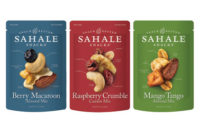Most people enjoy chocolate. According to Mintel, 85 percent of U.S. consumers buy chocolate. And Euromonitor estimates U.S. consumers eat an average of 9.5 lbs. of chocolate per year.
Today’s consumers have had a bit of a shift in dietary attitudes and are often looking for a combination of a great sensory experience, healthier products and transparency—three aspects that mesh perfectly with chocolate.
From bean to bar
“We expect to see products using chocolate grow, especially those labeled as natural or organic, and associated with terms authentic and real. The sustainability story around chocolate and the relationship with farmers and communities who harvest cocoa is becoming an increasingly important consideration when consumers purchase certain brands. While taste will remain a key driver, the story of the journey the cocoa bean makes to the final product is taking a priority position, as well,” shares Nina Jacobson, market research manager, Kerry, Beloit, WI.
Several companies are making commitments to support sustainable practices. Cargill Cocoa & Chocolate, Milwaukee, is increasing the volume of certified cocoa and delivering the Cargill Cocoa Promise—the company’s commitment to help develop a sustainable supply of cocoa while improving the livelihoods of cocoa farmers, notes Wyatt Elder, R&D technical leader.
Chicago-based Barry Callebaut recently released its “Forever Chocolate” strategy, which outlines the plans to make sustainable chocolate the norm. One of the company’s goals is to have 100 percent sustainable ingredients in all of their products by 2025, shares Seema Kedia, senior manager, marketing and sustainability.
Healthy indulgence
Trends like clean label and healthier snacking are driving new formulation opportunities for chocolate in the snack category. According to Harbinder Maan, associate director, trade marketing and stewardship, Almond Board of California, Modesto: “There is great opportunity for manufacturers to partner chocolate with nutritious ingredients, such as almonds. California almonds have the unique ability to enhance the flavor, texture and health factors of a chocolate product while helping to create a premium and indulgent consumption occasion.”
Consumers are familiar with the health benefits of chocolate. According to Mintel, dark chocolate product launches have increased 31 percent in the past four years. “Dark chocolate is perfectly positioned to impart the indulgent flavor that consumers demand while carrying a healthy halo for its high antioxidant content and association with heart health,” says Cassandra Edwards, senior marketing manager, Kerry.
Consumers are also interested in reducing their intake of sugar. “Almond butter is a great option for product developers looking to bring natural sweetness and creaminess to chocolate snacks, and its versatility and subtle flavor complements emerging ingredients in the category. These include spices, herbs or fruits with positive consumer perception such as clove, chili, cinnamon, cayenne, banana, cranberry and maca,” says Mann.
Chocolatier Richard Cusick of Evolution Artisan Confections, Valparaiso, IN, showcased these trends by developing an Almond Bark concept made with sliced almonds, organic puffed quinoa, dried Michigan cherries, vintage merlot sea salt and dark chocolate for the Almond Board of California.
Clean label and health
Barry Callebaut recently introduced a new cocoa powder under their Bensdorp brand, called Bensdorp Clean. Bensdorp Clean is a new cocoa powder that is alkalized with baking soda. The product is labelled as “cocoa processed with baking soda” instead of “cocoa processed with alkali.” According to Kedia, “Many consumers are not familiar with the term alkali, so Bensdorp Clean provides the traditional color and flavor of alkalized cocoa powder with a cleaner, more consumer-friendly label.”
Barry Callebaut conducted research and asked consumers their preference in comparing cocoa powder labeled as cocoa processed with baking soda vs cocoa processed with alkali. More than half of the consumers indicated they prefer to purchase the product processed with baking soda, as they think it is more premium and agree that it’s an improvement. “Bensdorp Clean is a great option, especially for bakery applications where baking soda is already a likely ingredient and using this cocoa powder may allow for a reduction in added salt,” states Kedia.
Barry Callebaut also introduced a new line extension to its Coco Niu portfolio. Coco Niu includes coatings and inclusions sweetened with coconut sugar. “Coconut byproducts, namely coconut water and oil, have been trending with consumers, and now chocolate sweetened with coconut sugar allows snack producers and bakers to ride the coconut wave. Coconut sugar also registers lower on the glycemic index than standard beet or cane sugar. The newest product in the Coco Niu portfolio is a dark chocolate chip, which functions well across a variety of snack and bakery applications,” says Kedia.
Cargill has recently released a report that identified four key trend areas for cocoa and chocolate—indulgent, premium, healthy, and sustainable and clean:
- Indulgent—delivering an indulgent experience across flavor, texture and color
- Premium—artisanal, provenance and origin
- Healthy—consumers are looking to minimize ingredients perceived as unhealthy, incorporating ingredients viewed as beneficial into their diets
- Sustainable and clean—where food is sourced from, how it was produced and the ethical and environmental impact, along with transparency and clean attributes
The ability to manage the opposing dimensions of sensory and health is a key area of focus for Cargill. Elder notes, “This manifests itself in the form of a cocoa and chocolate portfolio that spans areas such as reduced-sugar options, protein fortification, clean label and organic offerings.”
Sugar reduction is top of mind with consumers, and Cargill offers reduced-sugar chocolate, as well as sugar-reduced or sugar-free chocolate coatings and fillings, as part of their portfolio of chocolate, compound and confectionery coating offerings. Elder continues, “Within the snack and bakery segments, there is a great opportunity to leverage Cargill’s Truvia—naturally sourced from the stevia leaf—and other high-intensity sweetener knowledge to deliver unique products with an improved sensory profile.”
Protein fortification is another area where Cargill is leveraging the breadth of its product portfolio. The supplier provides added protein capabilities via dairy- and plant-based sources to fortify the chocolate or compound coating and deliver a functional and/or nutritional benefit. “We continue to see growth in the use of chocolate coatings and inclusions that deliver a nutrient such as protein or fiber,” continues Elder.
In addition to protein fortification, clean label continues to be important across categories. “For Cargill Cocoa & Chocolate, that means offering customers choices such as the removal of artificial colors and flavors, and flexibility to switch from soy-based emulsifiers (lecithin) to sunflower-based emulsifiers,” Elder notes.
Cocoa extracts and flavors
Kerry’s Cocoa Centre of Excellence, located in Grasse, France, is staffed with leading experts in cocoa processing, extraction and distillation. Unique processing technology enables high-quality and authentic extracts, from low to high concentrate, shares Michel Aubanel, global flavor ingredients manager. Kerry extracts 100 percent natural cocoa powder without alkalization to keep the profile natural, states Nathan Simon, associate buyer, cocoa. Simply Nature, a line of natural extracts and distillates, offers a range of cocoa and chocolate products, including extracts, distillates, infusions and tinctures. These can be used on their own or as foundations for creating flavors.
According to Amy Peterkes, RD&A senior scientist: “Kerry offers cocoa/chocolate keys that are essential taste building blocks for natural finished cocoa/chocolate flavors. Currently we have three organic-certified chocolate flavors suitable for bakery, sweet and snack: Tootsie Roll, Hot Chocolate and Brownie Batter.”
Kerry is utilizing new technologies to offer innovative, high-performing, bake-stable fat-coated flavors. “These encapsulated flavors are suitable for all baked goods and provide improved sensory experience and increased bake stability, and intensified natural brown flavor, aroma and mouthfeel. We offer both dark chocolate and milk chocolate varieties, among others. Our technologies work to enhance the chocolate flavor profile and improved positive sensory attributes of the flavors,” shares Davide Foà, business development manager, flavor technology, Kerry, Mozzo, Italy.
Organic options
According to the International Cocoa Organization, the organic cocoa market represents a small share of the total cocoa market, approximately 0.5 percent. However with consumer increased interest in transparency, food safety and supply, and overall health and wellness, the demand for organic cocoa product is expected to grow. Based on Mintel GNPD data, launches of chocolate confectionary products with an organic claim grew 6 percent between 2014 and 2016. Euromonitor estimates the organic chocolate market will reach $886 million by 2018.
Ciranda, Hudson, WI, is committed to providing manufacturers with high-quality, certified-organic, non-GMO and fair-trade ingredients. “Our program includes over 1,000 producers who receive a premium for cultivating their land organically, and an additional premium for fair trade, which also guarantees farmers a minimum price for beans even if the market price dips. Part of the fair-trade premium goes to the farmer groups and cooperatives who use the funds to advance their communities, for example restoring water, improving infrastructure or investing in healthcare or community schools” shares Tonya Lofgren, marketing manager.
“Currently, our organic cocoa and chocolate supply is strong, but to keep pace with growing demand we are expanding our program this year to include additional producers,” continues Lofgren. “We have also added new chocolate shapes—kibbles—to offer melting and enrobing clients a more cost-effective option compared to traditional chips and wafers.”
Cocoa butter alternatives
Weather and growing conditions can impact the supply of cocoa beans, and cocoa butter alternatives can provide an option for fluctuations in supply in certain applications. Compound or confectionary coatings are comprised of cocoa, sugar and a variety of plant-based fats. AAK USA, Edison, NJ, supplies specialty vegetable fats and oils to the chocolate and confectionary industries and has a portfolio of cocoa butter substitutes and cocoa butter equivalents for compound coatings, as well as confectionary fats for fillings, inclusions, caramels and other uses.
ILLEXAO is AAK’s brand of cocoa butter equivalents; the products have the same triglyceride composition and physical properties as cocoa butter. “These exceptional-performance confectionary fats are non-hydrogenated, contain no trans fats and provide smooth meltdown. They are highly compatible with cocoa butter, since they have similar physical and chemical properties,” shares Ramesh Reddy, customer innovation manager. ILLEXAO 85 can be used in combination with AAK’s Confao 55, a high-performance milkfat replacer that provides a soft, creamy filling sensation while inhibiting bloom and fat migration.
With the range of available options, the snack and bakery industry is well positioned to continue to grow along with consumers’ love of chocolate.








